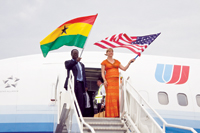
AMERICA’S United Airlines recently became the first to conduct trans-Atlantic flights using state-of-the-art flight planning to reduce environmental impact and save fuel.
The flights, which took place on World Environment Day, saved nearly 6,400 pounds of fuel and reduced carbon dioxide emissions by nearly 20,000 pounds.
United used a flight-planning system to compute optimum routing, altitudes and speeds based on winds and aircraft performance capabilities and partnered with NAV Canada, Canada’s civil air navigation service, and NATS, the UK’s leading provider of air traffic control services.
The flights were conducted as part of several efforts aimed at advancing technological and process improvements that will contribute to environmental sustainability and increased fuel savings.
“We are focused on affecting a permanent change in flight planning and routing over the North Atlantic to achieve significant environmental impact improvements,” said Joseph Kolshak, United Airlines senior vice president of operations. “We expect this effort will serve as a model for how co-operation and co-ordination can generate meaningful progress in our drive to protect the environment and improve our operational efficiency.”
United, which earlier this year launched flights from Bahrain to the US via Kuwait, has also recently celebrated the inauguration of a daily service between Accra, Ghana, and Washington DC (pictured).
Airline senior vice president alliances, international and regulatory affairs Mark Schwab said: “This new destination, a first for United in Africa, extends our international footprint and further strengthens our route network. Our Washington Dulles hub will provide our customers with connections to more than 90 cities across North America. Combined with the first-rate service we offer on board, this is a winning combination for travellers from Ghana and other parts of Africa.”
And, in a further triumph, United has been announced as first in on-time performance, as measured by the US Department of Transportation (DOT) in the first quarter of 2010, when compared to America’s five largest global carriers. 82.5 per cent of the airline’s domestic flights arrived at their destinations within 14 minutes of the scheduled arrival time, a 2.1 point improvement overall on the first quarter of 2009.
